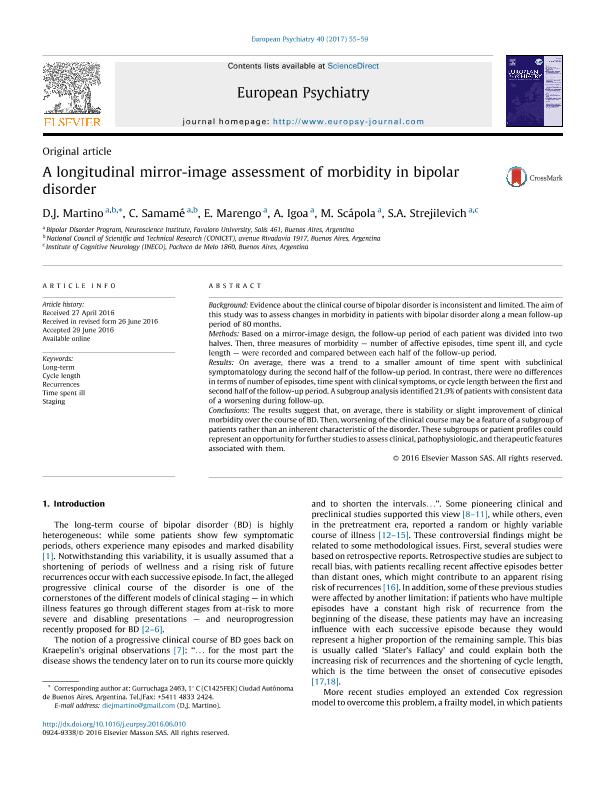Mostrar el registro sencillo del ítem
dc.contributor.author
Martino, Diego Javier

dc.contributor.author
Samame, Cecilia

dc.contributor.author
Marengo, E.
dc.contributor.author
Igoa, A.
dc.contributor.author
Scápola, M.
dc.contributor.author
Strejilevich, S. A.

dc.date.available
2018-12-06T18:26:33Z
dc.date.issued
2017-02
dc.identifier.citation
Martino, Diego Javier; Samame, Cecilia; Marengo, E.; Igoa, A.; Scápola, M.; et al.; A longitudinal mirror-image assessment of morbidity in bipolar disorder; Elsevier France-editions Scientifiques Medicales Elsevier; European Psychiatry; 40; 2-2017; 55-59
dc.identifier.issn
0924-9338
dc.identifier.uri
http://hdl.handle.net/11336/66007
dc.description.abstract
Background Evidence about the clinical course of bipolar disorder is inconsistent and limited. The aim of this study was to assess changes in morbidity in patients with bipolar disorder along a mean follow-up period of 80 months. Methods Based on a mirror-image design, the follow-up period of each patient was divided into two halves. Then, three measures of morbidity — number of affective episodes, time spent ill, and cycle length — were recorded and compared between each half of the follow-up period. Results On average, there was a trend to a smaller amount of time spent with subclinical symptomatology during the second half of the follow-up period. In contrast, there were no differences in terms of number of episodes, time spent with clinical symptoms, or cycle length between the first and second half of the follow-up period. A subgroup analysis identified 21.9% of patients with consistent data of a worsening during follow-up. Conclusions The results suggest that, on average, there is stability or slight improvement of clinical morbidity over the course of BD. Then, worsening of the clinical course may be a feature of a subgroup of patients rather than an inherent characteristic of the disorder. These subgroups or patient profiles could represent an opportunity for further studies to assess clinical, pathophysiologic, and therapeutic features associated with them.
dc.format
application/pdf
dc.language.iso
eng
dc.publisher
Elsevier France-editions Scientifiques Medicales Elsevier

dc.rights
info:eu-repo/semantics/openAccess
dc.rights.uri
https://creativecommons.org/licenses/by-nc-nd/2.5/ar/
dc.subject
Cycle Length
dc.subject
Long-Term
dc.subject
Recurrences
dc.subject
Staging
dc.subject
Time Spent Ill
dc.subject.classification
Medicina Critica y de Emergencia

dc.subject.classification
Medicina Clínica

dc.subject.classification
CIENCIAS MÉDICAS Y DE LA SALUD

dc.title
A longitudinal mirror-image assessment of morbidity in bipolar disorder
dc.type
info:eu-repo/semantics/article
dc.type
info:ar-repo/semantics/artículo
dc.type
info:eu-repo/semantics/publishedVersion
dc.date.updated
2018-11-02T17:31:11Z
dc.journal.volume
40
dc.journal.pagination
55-59
dc.journal.pais
Francia

dc.journal.ciudad
Paris
dc.description.fil
Fil: Martino, Diego Javier. Consejo Nacional de Investigaciones Científicas y Técnicas; Argentina. Universidad Favaloro; Argentina
dc.description.fil
Fil: Samame, Cecilia. Consejo Nacional de Investigaciones Científicas y Técnicas; Argentina. Universidad Favaloro; Argentina
dc.description.fil
Fil: Marengo, E.. Universidad Favaloro; Argentina
dc.description.fil
Fil: Igoa, A.. Universidad Favaloro; Argentina
dc.description.fil
Fil: Scápola, M.. Universidad Favaloro; Argentina
dc.description.fil
Fil: Strejilevich, S. A.. Universidad Favaloro; Argentina. Instituto de Neurología Cognitiva; Argentina
dc.journal.title
European Psychiatry

dc.relation.alternativeid
info:eu-repo/semantics/altIdentifier/doi/https://dx.doi.org/10.1016/j.eurpsy.2016.06.010
dc.relation.alternativeid
info:eu-repo/semantics/altIdentifier/url/https://www.sciencedirect.com/science/article/pii/S092493381630075X
Archivos asociados
